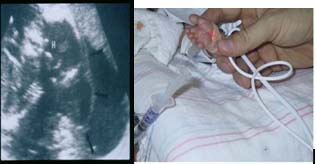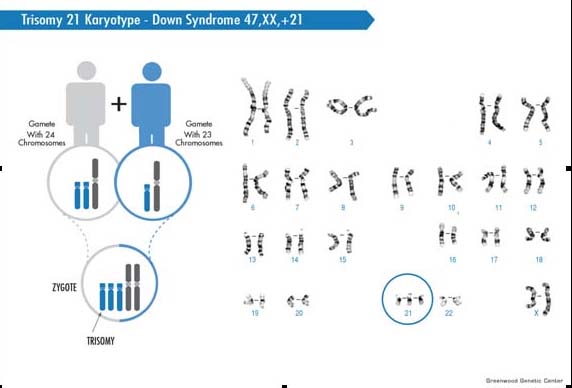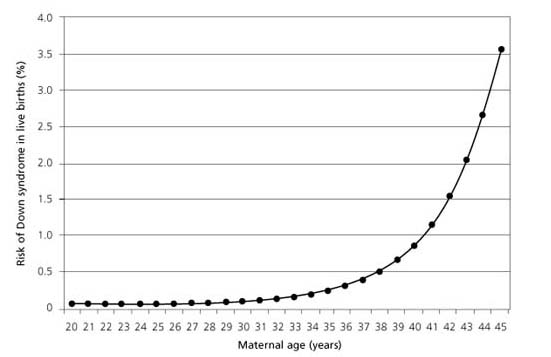Down syndrome
Down syndrome was first described as a syndrome in 1850 by Dr. Down. He noted that a number of children that were delayed in development had similar physical features with each other. This is one of the first, best described “syndromes”.
Clinical features of Down syndrome include small head (microcephaly), flat face, small ears, single palmar crease, and a wide space between the 1 st and 2 nd toes (figure 1). In 1920 it was noted that children with Down syndrome improved when they were given thyroid hormone. In 1959, Dr. Lejeune discovered that Down syndrome was a result of patients having an additional chromosome 21. On further study, it has been estimated that approximately 95% of all patients with clinical features consistent with Down syndrome have an additional chromosome 21 (figure2). Two percent of Down syndrome patients have a translocation between chromosome 21 and another acrocentric chromosome (13, 14, 15, 22), with the remaining 2-3% of patients having “mosaic” Down syndrome. This is when some of the cells have an additional chromosome 21 and some have a normal chromosome number.
1/500 babies born are affected with Down syndrome. While the majority of children with Down syndrome children are born to women under the age of 35, the risk of having a baby with Down syndrome increases with maternal age. The risk of having a baby with Down syndrome at age 21 is 1/1000. The risk of having a baby with Down syndrome at age 45 is approximately 1/9 (Figure 3).
Children with Down syndrome are at increased risk for a number of medical complications. Between 50% and 70% of babies born with Down syndrome have a congenital heart defect. The most common CHD is VSD. AV canal is a defect most specific for children with Down syndrome. Hypothyroidism is also common in children with Down syndrome. The risk of hypothyroidism is 28X the general population. There is both congenital and acquired hypothyroidism. Congenital and acquired hearing impairment is also more common in the Down syndrome population than the general population. They are also at increased risk for otitis media. This can also result in conductive hearing impairment.
Prenatal signs of Down syndrome include increased nuchal thickness, congenital heart defects, and shortened femurs. The nuchal thickness is most accurate as a sign of Down syndrome in the first trimester. There is also serum screening available in the first and second trimester.
As individuals with Down syndrome age they are at risk of developing a number of additional medical problems. Mitral valve prolapse can develop in adults with Down syndrome even in the absence of congenital heart defects. Alzheimer's disease develops in the majority of individuals with Down syndrome.

Figure 1.

Figure 2.

Figure 3.
A newborn is noted to have a heart murmur. She has small ears, tongue thrusting and a thick nuchal fold. The baby does not tolerate p.o. feeding. She spits up her first feed and appears in distress.
- What is the possible cause of her inability to feed?
- What studies would be important to determine the extent of her medical problems?
- What is the risk of the family having another child with the same disorder?